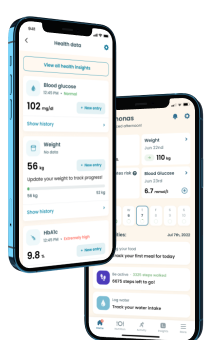Is Diabetes Genetic? — A Guide on Diabetes’ Hereditary Risk

Diabetes is one of the conditions that experts and various health institutions have recommended different ways to tackle. The condition is among the most popular chronic diseases with a high mortality rate. According to top health institutions like the American Diabetes Association (ADA) and the Center for Disease Control and Prevention (CDC), over 20 million Americans have the condition. This staggering stat justifies the continuous sensitization to help people know how to prevent and control the condition.
The major factors that experts try to control are those that people with the condition can avoid or take proactive steps towards for better health security. For example, dieting is one of the steps recommended for people with diabetes to help prevent the worsening of the condition and live healthier.
However, while one can control most factors that increase the risk and complication of the disease, one is generally uncontrollable — genes. Experts believe it plays a significant role in causing the condition.
Genetics isn’t just believed to be one of the many diabetes risk factors; it’s considered the main reason for diabetes in most people. Many studies back the stance that diabetes is genetic, with people who already have affected family members having a higher risk of getting it.
This guide deeply highlights the role of genes in diabetes development and tips that genetically disadvantaged people with the condition can do to manage their health better.
Diabetes and Genetics: A Broad Overview
Diabetes is an autoimmune disease that’s significantly dangerous to health and even life. It’s often recommended that people who suffer from the condition adopt healthy life practices that help control their condition.
Experts believe that the vast number of persons with undiagnosed diabetes in the United States are those who’re genetically compromised. A large proportion of these people don’t know they have a serious diabetes disease risk. In fact, it’s often until the disease becomes worse and negatively affects their health and life before they become aware that something isn’t right.
However, while studies have good proof that diabetes is genetic, the situation isn’t entirely black and white. First, the reality is that most people that have the condition are naturally genetically compromised. “Compromise” here doesn’t mean that people having a genetic diabetes risk have bad or non-sustainable genes. Rather, it pinpoints that they have diabetes-inclined genes that could trigger the condition when other factors come into play.
Many observations have shown that not everybody with genetic vulnerability will have diabetes. There are records of many genetically vulnerable people due to inherited compromised genes who’ve never had diabetes. Observed studies have shown that those with diabetes typically suffer from more than genetic factors. Other factors, including environmental, diet, and lifestyle factors, are the major triggers of the condition in people with a genetic vulnerability.
Experts in large-scale association analysis studies performed by top government institutions like the ADA and CDC prove that inheritability is nothing more than a genetic contribution that would never lead to diabetes on its own. Several risk factors have to be present in a person with a genetic predisposition to the disease for them to have diabetes. Most people who develop diabetes, especially type 2 diabetes, are affected by genetic and lifestyle factors. Summarily, it’s somewhat difficult for a person without any genetic predisposition for diabetes to develop the condition.
The topic of genetic roles in having diabetes is pretty extensive. A person who inherits a risk for the condition usually has at least one gene mutation. The condition only develops if there are more mutations of the genes, and this is only possible with unhealthy behavioral patterns.
This pattern usually includes poor dieting, especially excessive consumption of sugar-concentrated foods. Also, lack of exercise and a heightened intake of carbonated drinks escalate gene mutations.
People who suffer from high gene mutation will develop the disease and also pass their altered genes to their offspring. This phenomenon has been proven through different studies suggesting that the latter cycle of offspring from a family of diabetes has a higher risk of developing the condition than earlier offspring. The reason isn’t far-fetched — offspring from the latter set usually have more altered genes than those birthed years back. The trend—which is of clinical relevance—outlines how much behavioral factors increase the risk of diabetes in people who already have a genetic predisposition.
Research and Experts’ Take on the Role of Genetics in Diabetes
Many studies and experts alike outline how genes play a major role in increasing the risk of diabetes in people
Monica Alvaro, a licensed genetic counselor, and the regional administrator for genetic services in Kaiser Permanente in Pasadena, California, explains how people develop diabetes. She stated that most people who have diabetes are usually susceptible to genetic and environmental factors.
Monica Alvaro speaking more on type 2 diabetes and genetics, said the influence of family history increases the risk of people having type 2 diabetes more than other types of diabetes. She asserts that the increased risk is because people with type 2 diabetes also have family members with risk factors like obesity.
A 2013 research on how genetics influence type 2 diabetes proves that people can inherit the disease from one of their parents, both parents, or a first-degree relative. Here’s an outline of how this plays out in each case:
- One Parent: In this case, a person who has a parent with type 2 diabetes has a 40% lifetime risk for the disease.
- Both Parents: A person whose both parents have type 2 diabetes has a 70% risk of having the disease.
- First-Degree Relative: As people, we share 50% of our genes with a first-degree relative. The research suggests that you are three times at risk of developing the disease if you have a first-degree relative with type 2 diabetes.
The main study that explicitly proves how much role genetics play is twin studies. Twin research on diabetes is among the most popular proof that the condition is connected to genetics. The study featured almost 35,000 pairs of twins from different countries to study the progression of type 2 diabetes while ensuring randomness. The countries involved in the study were Spain, Sweden, the United Kingdom, the Netherlands and Australia.
The study aims to identify if twins that share the same ancestry with diabetes are more likely to have altered genes than those who don’t share such ancestry. The research’s second focus was to study monozygotic twin pairs and share ancestry with people with altered diabetes genes against those that share the same ancestry but aren’t monozygotic. Of the total twin sets, 13,970 twin pairs were monozygotic with type 2 diabetes risk.
The result of the research showed that of all the twins with type 2 diabetes genetic risk, monozygotic twins were more likely to develop the condition than fraternal twins. This result confirmed that the more similar twins’ genes are, the more likely they both are to develop diabetes if they inherited their ancestry’s risk of the disease. In other words, the result confirms that diabetes is genetic.
Also, the result reinforced the claim that twin pairs that have ancestors with diabetes are more likely to develop the condition compared to those whose ancestors don’t have diabetes.
While both results show that diabetes is truly genetic, it’s important to note that the result of the research was complex due to the environmental factors that also play a contributing role in diabetes development and respective complications.
The subsequent sections outline how much genetics influence diabetes and the role of other lifestyle factors in causing more gene alterations.
Identifying the Genes
As stated in the above section, diabetes is more paramount in families with a history of the condition. It’s also confirmed that other factors like lifestyle, environment, and diet help it become active in patients with genetic predispositions.
There are major genes responsible for the inheritance of diabetes traits from one’s ancestors or immediate parents. Experts confirm that several gene mutations affect the risk of type 2 diabetes. Although the input of each gene is relatively small, additional mutations—mostly occurring in potential diabetics—usually trigger the condition or its risk.
According to expert studies, mutations in the gene connected to maintaining sugar levels can increase your chances of having type 2 diabetes. This revelation shows how much the diet choice of a person already exposed to diabetes risk can activate the condition. The major genes responsible for inherited diabetes include:
- Genes responsible for the production and management of insulin
- Genes responsible for producing glucose
- Genes responsible for how the body recognizes glucose levels
The specific genes that studies have been able to connect with the risk of diabetes include the following:
TCF7L2
The TCF7L2 is the gene that influences the production of glucose and insulin secretion.
CAPN10
This gene is connected to the risk of type 2 diabetes in Mexican Americans.
ABCC8
The ABCC8 gene helps manage insulin.
GCGR
The GCGR is a glucagon hormone that helps in the regulation of glucose.
GLUT2
This gene helps the movement of glucose to the pancreas.
HNF4A
This gene manages glucose in the pancreas and liver.
KCNJ11
This is the gene responsible for the activation of insulin release and is meant for potassium passage.
PIK3R1
The PIK3R1 gene plays a vital role in the signaling of insulin.
PPARG
This is the gene that helps manage the differentiation of fat cells.
LPL
The LPL is a water-soluble enzyme known as the lipoprotein lipase and is responsible for breaking down fat (triglycerides).
Ethnicity and Diabetes: How Do Social Groups Influence the Condition?

One of the major areas of genetics is ethnicity. This particular metric is much bigger than the role of ancestry as it gives a broad view and better explanation of why certain individuals are more predisposed to diabetes than others. Ethnicity considerations usually focus on people from certain races and regions and their interaction with diabetes.
Type 2 diabetes affects people over 45 years and is found in 92–95% of people who have diabetes. The National Institute of Diabetes and Digestive and Kidney Diseases (NIDDK) suggests that being obese or overweight is a significant risk that exposes people to the disease. However, people from various ethnic groups can also be at risk of the illness if the measurement of their body weight—the body mass index—sits at 25 or more.
For example, people from the Pacific Islands, known as the Pacific Islanders, are at risk of type 2 diabetes if their body mass index is 26 or more. Similarly, Asian Americans are exposed to the condition if their body mass index is 23 or more.
There are other ethnic groups who—despite not being obese—are known to have a high risk for type 2 diabetes. This group includes the American Indians, Alaska Natives, Latinos, Hispanics, and Native Hawaiians.
The following tables offer a comprehensive look into how ethnicity influences the risk of diabetes among Americans:



| Type of Diabetes | Ethnic Groups at Risk |
| Type 1 diabetes | African American & Hispanic/Latino American |
| Type 2 diabetes | African American, American Indian, Alaska Native and Hispanic/Latino American |
| Prediabetes | American Indian, African American, Alaska Native, Hispanic/Latino American |
| Gestational diabetes | American Indian, African American, Hispanic/Latino American, Native Hawaiian, Alaska Native, and Pacific Islander |
Ethnic Group
Rate of Diagnosed Diabetes (%)
Non-Hispanic whites
7.5
Asian Americans
9.2
Overall Hispanic Americans
12.5
Non-Hispanic Blacks
11.7
Native Alaskans
14.7
Native Americans
33
The Environment: A Major Factor That Triggers the Condition in People With Possible Genetic Compromise
Epigenetics processes occur when one’s genes connect with their environment to either allow their genes to be in control or not. This process plays a vital role in the risk for type 2 diabetes. While epigenetic changes can’t alter the DNA sequence, they influence the expression of the genes.
However, environmental factors like infection, exercise, and diet can also cause an epigenetic change. A 2020 paper shows that dietary fiber and carbohydrates can alter genes and cause serious mutations that increase type 2 diabetes.
The role of the environment in diabetes is highly important and has just as much influence as genetics. People who successfully manage their external factors are often safe from developing diabetes and will live a healthy normal life. On the other hand, people who don’t pay any real attention to dieting are more likely to experience serious issues with their health and could develop diabetes fully.
Certain environmental factors pose serious risks to people already genetically compromised, and it’s critical to know them to help implement healthy practices. Some of the major environmental risk factors you should be concerned about include the following:
- Having incredibly poor eating habits and patterns
- Being 45 years or older
- Being overweight
- Not being significantly physically active and not dedicating up to 3 times a week performing moderate to intense cardio
- Not having a sufficient HDL (“good” cholesterol) and yet having high triglycerides
- Not regularly visiting a doctor due to a perceived belief that you’re not ill. Males are much more often in this category as research indicates they’re less likely to visit a hospital to check up on their health status
- Having depression episodes often
- Being diagnosed with any heart disease, stroke or cardiovascular disease
All of the above conditions can single-handedly activate diabetes in people struggling with the condition due to their genes, ancestry or ethnicity.
The ADA’s Stance on Diabetes
Like many national institutes of health and diabetes, the American Diabetes Association (ADA) confirms that diabetes is indeed genetic. The organization asserts that people can inherit genes for the two types of diabetes.
However, they’re majorly docile and will only become a concern if other environmental factors cause more mutations. The organization outlines the importance of environmental factors contributing to the genetic condition by confirming that most twins are likely to have it with the probability of being three out of four. The high rate of twins getting the condition is mainly because of their genetic similarity and partly because they’re mostly exposed to the same environmental factors.
Due to the significant effect of environmental factors on diabetes, the ADA focuses on providing the general American public with tips and expert recommendations on how they can live more healthily. These tips majorly focus on deliberate personal decisions that one can make without the help of a physician.
The organization recommends diet adjustment and insulin therapy for those who already have the condition. Exercise is another major preventive and control measure that the health organization recommends for people at risk of getting the disease or experiencing further complications.
The ADA generally recommends safe and DIY methods for patients. However, there’s a serious emphasis on diagnoses if a person notices symptoms and signs that are somewhat common with diabetes. The body also recommends expert help in an event where self-applied control has become more difficult.
Expert help could be from an endocrinologist, enabling people at risk of the condition to apply the most effective treatments and methods of controlling the disease. The organization also recommends “support groups” for patients at risk or who already have diabetes. These groups usually comprise people with similar conditions pursuing a similar goal of living healthier and restricting the effect of diabetes in their life.
The Different Genetic Tests for Type 2 Diabetes
While it’s impossible to fix your genes if they’re genetically compromised, you can take certain steps to reduce their likelihood of causing diabetes. Most of the above sections have considered steps that people can take to reduce the effect of their genes in causing the condition. However, the first step one should take is to perform a test.
The best way to know whether you’re genetically vulnerable to diabetes is to perform certain tests that can predict and give you a better idea of your condition. Several tests can help people identify if they’re genetically compromised, and they include the following:
Genetic Test (Ancestry Test)
This test focuses on your family history and provides information on whether you have diabetes genes based on your ancestral tree. It’s among the most reliable predictors for patients with ethnic vulnerability.
Body Mass Index (BMI) Test
The BMI test provides information on whether you’re obese or have a healthy weight. This particular measurement calculates your weight with respect to your height.
High Blood Pressure Test
If you consistently test for high blood pressure, you’re extremely likely to be genetically vulnerable to diabetes.
The above tests can help a person know whether they’re genetically compromised or not. In addition, women who continually experience gestational diabetes during pregnancy and birth are usually also genetically vulnerable.
Tips to Prevent Diabetes
The relationship between the environment and genetics makes it challenging to determine the cause of type 2 diabetes. However, that doesn’t stop you from minimizing your risk by adjusting your habits and lifestyle.
A randomized clinical experiment from the Diabetes Intervention Accentuating Diet and Enhancing Metabolism in 2020 for people with type 2 diabetes shows that increased physical activity and weight loss can reverse or prevent type 2 diabetes.
The blood sugar level of some of the participants returned to normal, while others had diabetes remission. Other researchers have also discovered a similar result.
In light of these, the following tips can help you modify your lifestyle to lower your risk for type 2 diabetes, despite being genetically predisposed.
1. Create an exercise program.
Gradually include physical activity in your everyday routine. For example, you can choose to walk into your office building by parking your car far away or use the stairs to avoid the elevators. You can also choose to walk while going to the grocer or when going for lunch.
With time, you can include various cardiovascular activities and lightweight training into your weekly routine. For starters, you can begin your daily exercise with just 30 minutes.
However, seek your doctor’s opinion before deciding on your exercise routine. That’ll help you choose a plan that suits your needs and capacity, enabling you to derive the most health benefits from it while you exercise safely.
2. Eat meals based on planned resource meals.
The easiest way to live a life void of diabetes is to cook your food while choosing the nutrients you need the most.
Create a meal plan for every week that comprises dishes for each meal. Restock the necessary grocery items you need and arrange or prepare some of the ingredients before time to make everything easier for you. Start the process by planning toward your weekly breakfast or lunch, and when you get comfortable enough, add other meal plans.
You can use different help resources to create a diabetes-friendly meal plan. One of the popular and proven help resources is diabetes meal planning apps. A diabetes meal planner is an expert app that provides people who have diabetes or have a genetic risk of developing the condition to eat the right meals.
A good meal planning app suggests the best foods people with diabetes should eat and when to have them. Many experts consider these apps just as effective as the dietitian’s recommendation.
3. Go for nutritious snacks.
Choose snack options that can help fuel your body and increase your energy levels. The following are nutrient-dense and easy-to-eat types of snacks to try:
- Apples, clementines, pears, and other fruits
- Hummus, cucumber, and carrot sticks
Here are other handy tips on healthy snacks:
- Eat different nuts and pay attention to the serving size
- Eat cheese and whole-grain crackers
- Go for air-popped popcorn without adding lots of butter, sugar, or salt
4. Choose water instead of sugary beverages.
Drinking water instead of beverages would help limit your sugar intake. This is particularly true as sugary fruit juice and sweetened drinks are often associated with a heightened risk of latent autoimmune diabetes in adults (LADA) and type 2 diabetes. Research on 2,800 people discovered that participants who took more than two servings of sweetened beverages every day have a 20% chance of having type 2 diabetes and a 99% chance of having LADA.
Another research found that one serving of sweetened drinks every day could increase a person’s chance of having type 2 diabetes. This proves that more intake of water results in better insulin response and blood sugar control.
Furthermore, a 24-week experimental study found that overweight adults who use water in place of diet soda in their weight loss plan experienced a reduction in fasting blood sugar, insulin levels, and insulin resistance.
5. Avoid smoking.
Smoking has contributed to detrimental health conditions like intestinal and lung cancers, heart disease, and chronic obstructive pulmonary disease (COPD). Research has suggested smoking causes type 2 diabetes. Although the methods or process of this research aren’t fully understood, smoking is perceived to inhibit insulin secretion and increase insulin resistance.
Suffice to say, smoking heavily and more frequently increases the risk of having diabetes. Other critical research has shown that quitting smoking would decrease the risk of having diabetes.
6. Start a weight loss program.
Having excess weight could increase your chances of having type 2 diabetes. Excess weight such as visceral fat found around the abdominal organs and the midsection is associated with inflammation, prediabetes, type 2 diabetes, and insulin resistance.
Losing a small amount of weight, like 5–7%, could reduce your risk of having type 2 diabetes if you’re obese, overweight, or have prediabetes. Two years of research in over 1,000 people prove that dieting, weight loss plan, and exercise significantly lower the risk of having type 2 diabetes by 42–47% compared to participants in a control group.
There are several effective weight loss strategies. A great way to start is by having a balanced dish with lean proteins, healthy fat, non-starchy vegetables, and complex carbs.
Departing Words and Summary
Diabetes is genetic, and most people with the disease are those who inherit altered genes. The condition is often triggered in most people when other lifestyle factors exacerbate their genetic vulnerability to cause more altered genes. Realistically, some people with genetic compromise won’t have the disease if they manage other parts of their lives well. As such, it’s critical to consider other factors—apart from genetics— for proper prevention or management of the condition.
This comprehensive guide highlights several lifestyle factors that require proper management to reduce the impact of the genetic factor. Some of these factors include incorporating healthy exercise habits and proper dieting. These two factors are majorly responsible for the activation or prevention of diabetes in people already genetically compromised.
Unhealthy dieting, especially, is the major risk factor—after genetics—that causes diabetes. The types of foods you eat determine how much blood sugar rises or falls. This justifies why health experts and endocrinologists emphasize proper eating.
If you’ve performed a series of genetic analyses and are confirmed to be genetically vulnerable to diabetes, eating poorly will only lead to a higher risk of developing the disease. It’s essential that you meet a dietitian to help you choose the right food that works with your system for the best effect.
Alternatively, you can opt for a diabetes management meal app to get the best foods that work well for you. Our Klinio app is among the major apps you can trust for diabetes-friendly foods. Notably, the foods listed in our diet portfolio are regularly updated and are incredibly healthy for people who want to control the risk of poor dieting for diabetes. They’re also compatible with people managing their insulin-dependent diabetes mellitus and seeking to avoid further complications.
Take a quiz and get your diabetes-management plan today!









